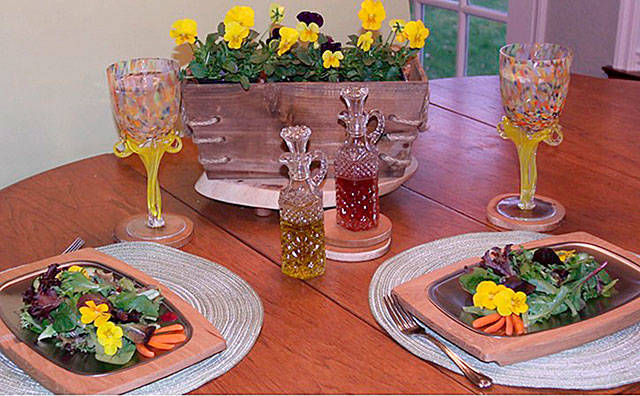by Judy English and Jeanette Stehr-Green
Perk up your patio, your landscape and your salad with flowers.
These beauties can be grown in a container or planted directly into the landscape. Nestle them between non-flowering plants to add a splash of color, border your vegetable garden with them to attract bees or make them the star attraction of a planting area. They all bring a bright, happy addition to the environment.
Most are easy to grow in the Northwest coastal climate and all benefit from being deadheaded. The more you pick to use in salads and cut to enjoy in a bouquet the happier these plants are and the less deadheading you need to do — a “win-win”!
Here are a few favorites:
Marigold (Tagetes tenuifolia)
Not all marigolds are tasty enough to eat. Select signet marigolds (with names like ‘Lemon Gem,’ ‘Golden Gem’ and ‘Tangerine Gem’) to add to your salad. Remove the bitter white part at the base of the petals and scatter the colorful petals on top of salad greens to make a dazzling presentation. Plant marigolds in full sun.
Calendula (Calendula officinalis)
Calendulas bloom over a long season if you harvest or deadhead them regularly. Once cut, they will stay fresh in a vase for five days. Calendulas thrive in a sunny location with regular watering. Zinnias are from the same family as calendulas (Asteraceae or Compositae) and have similar characteristics and environmental preferences. Both calendulas and zinnias are old-time favorites and their bright colors are striking in a green salad.
Violas (Viola spp.)
Pansies, violas, violets — all are “happy” flowers that provide interest and color. The heat of summer occasionally can cause violas to grow lanky but that is unusual here on the Olympic Peninsula. If it happens, a severe pruning will cause them to re-grow producing a fresh crop of flowers in the fall. Violas can handle a bit of shade from the afternoon sun.
Bachelor Button (Centaurea cyanus)
Also called “cornflower,” this one is very easy to grow needing little more than sun and water. If you want a deep blue, red, pink or white flower for garnish, bachelor buttons are for you.
Dianthus (Dianthus barbatus)
“Sweet William,” “Pinks” — they are all the same. Dianthus prefers to be planted in full sun but with a bit of a break from the intense afternoon sun. Like marigolds, remove the bitter white portion at the base of the petals. These spicy petals are used most often on desserts and fruit salads.
Nasturtiums (Tropaeolum majus)
Nasturtium is one of the most versatile plants because both the flowers and the leaves are edible. The petals add a peppery flavor and sassy color to pasta, egg salad and potato salad. The leaves are spicy with a texture similar to watercress. Nasturtiums can tolerate poor soil and periods of limited water, but will be abundant and put on quite a colorful show when given richer soil and adequate moisture.
Other edible blossoms include old-time favorites that have brightened home landscapes for decades. (See sidebar.)
But keep your family safe by following a few general rules. (See sidebar.)
Know which flowers are edible and make sure they have been collected from a safe setting.
Transform your yard into the bright spot of the neighborhood and your green salad into a colorful, tasty treat!
Pearl of wisdom
Do your research. Never experiment by eating plant parts unless you can identify the plant and know that it is harmless. If you know one part of a plant is safe to eat, do not assume that all parts will be. Even if an animal consumes the flower, it still could be toxic to humans.
Judy English and Jeanette Stehr-Green are Washington State University-certified, Clallam County Master Gardeners.
Additional edible flowers and flavors
Borage (Borago officinalis) — light cucumber flavor
Garden chive (Allium schoenoprasum) — mild onion flavor
Garlic chive (Allium tuberosum) — mild garlic flavor
Squash (Cucurbita pepo species/zucchini) — squash-like flavor
Calendula petals (Calendula officinalis) — tangy, peppery flavor
Daylily petals (Hemerocallis sp.) — asparagus, squash, lettuce, melon flavors
Roses (Rosa sp.) — sweet, aromatic flavor, stronger fragrance produces a stronger flavor (remove the bitter white portion of petals)
Culinary lavenders (Lavendula) — different varieties provide different flavors
When eating flowers:
• Know what you are eating and how it has been grown.
• Do not eat a flower that has been treated with chemicals.
• Do not use flowers found along the roadside.
• Use only the petals from composite flowers (daisy-like flowers). Their pollen is allergenic and may cause reactions in some individuals.
• Blossoms should be eaten the day they are picked. For maximal freshness, pick early or late in the day when blossoms are cool.
• Before using, gently wash flowers and remove the stamens (pollen producing part of plant) and styles (part that receives the pollen).
Coming events, opportunities
• Thursday “Brown Bag” Series
Noon-1 p.m., commissioners meeting room in the Clallam County Courthouse, 223 E. Fourth St., Port Angeles
Next up is “Drought Tolerant Gardening” with Master Gardener Elaine Webber
• Second Saturday Garden Walks
Set for 10-11:30 a.m. on June 10, at the Fifth Street Community Garden, 328 E. Fifth St., Port Angeles, this is an educational walk led by Master Gardeners which will cover a variety of food crop topics. Gardeners also will discuss what is happening in our Clallam County Gardens during June.
• Annual Garden Tour
10 a.m.-4 p.m. Saturday, June 24
Gardens in Sequim will be featured this year. This is a unique opportunity to gain inspiration from private gardens within our community. For ticket sales and garden locations, visit ext100.wsu.edu/clallam.


